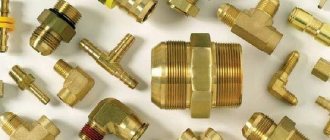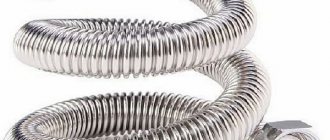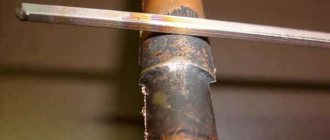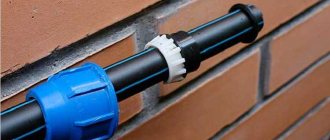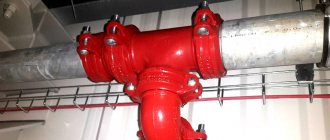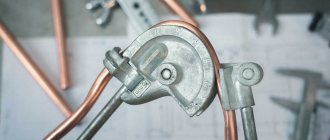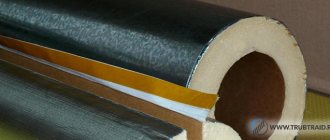Pipe products made of copper, as well as fittings for connecting copper pipes, allow you to create reliable and durable communications, distinguished by a number of unique properties. The advantages and quality characteristics that distinguish such pipelines largely explain their rather high cost.
Copper fittings and pipes for water supply
Communications made of copper pipes and fittings
High-quality copper pipes and fittings, the technical and operational characteristics of which comply with international standards ISO 9002, BS2 and DIN, are today produced by both foreign and domestic companies. Such pipes, as well as connecting elements for them, successfully withstand the high pressure of the media transported through them, high and low temperatures, and mechanical stress to which they may be subjected during operation, transportation and storage.
Unlike polymer pipes that are popular nowadays, copper pipe products do not deteriorate from exposure to sunlight; they are not afraid of corrosion, which is a real scourge for products made from ferrous metals. The service life of copper pipes and fittings cannot be compared with any similar product made from another material. It is noteworthy that copper products are practically eternal; the service life of communications from them is at least 100 years.
Heating and water supply system made of copper pipes in a private house
Pipe products, as well as fittings made of copper, are used for arranging utility networks for various purposes:
- heating systems;
- air conditioning;
- cold and hot water supply;
- gas communications.
Those consumers who decide to use copper pipe products and copper fittings primarily use them to build reliable and durable water supply networks. Fittings made from copper are more compact in size and look much neater than products made from ferrous metals. This is explained by the fact that when designing and manufacturing copper fittings, there is no need to make their walls thicker, taking into account their further corrosion, since they are simply not susceptible to it.
DIY installation of copper pipes in the heating system
There are several reasons explaining the high popularity of pipes and connecting elements for them made of copper:
- copper, as is known, has antiseptic properties, therefore, pathogenic microorganisms do not develop in water pipes made from this metal, and the quality of the water transported through them even improves;
- installation of pipelines for which pipes and fittings made of copper are used is much simpler than communications made of black pipes;
- due to the high ductility of copper, pipes made of this metal, when water freezes in them, do not burst, but simply deform; in order to destroy a copper pipe, it is necessary to apply an internal pressure of 200 atm to it, and such pressures simply do not exist in household communications.
What nuances exist?
To organize the creation of a pipeline system, pipes made of durable plastic are used. Stainless steel belongs to the expensive price segment, but reliability covers this nuance. For major repairs, a copper pipe can be a full-fledged alternative.
Such a system favorably tolerates sudden temperature changes and is not afraid of large amounts of chlorine or ultraviolet radiation. To avoid the development of corrosion, special devices are installed inside. If there are no compositions of heavy metals and other substances in the liquid, then nothing will prevent such pipes from serving for even a dozen years.
Among the significant disadvantages are the following aspects:
- Softness.
- High price.
The last drawback is considered completely justified due to the long service life.
Elements for copper pipe connections
Copper fittings, which are used to connect copper pipes, are presented on the modern market in a wide variety of sizes and designs. The most well-known types of such connecting elements are:
- threaded fittings for copper pipes;
- self-locking connecting elements;
- compression or crimp fittings;
- so-called press fittings;
- capillary type connecting fittings.
Of all the listed types of connecting elements, in our time, press fittings for copper pipes are the least used, which is explained by the following reasons: their installation requires the use of complex and expensive equipment: special presses. The design of press fittings was originally developed in order to connect plastic and metal-plastic pipes with their help, so their use for the installation of copper products is not always advisable.
Press fitting pliers
In order for a pipeline in the construction of which copper parts are used to serve as long as possible and be highly reliable, it is advisable to use elements made of homogeneous materials during its installation. Connecting copper pipes with fittings that are made from other raw materials should only be done in rare exceptions.
If it is not possible to avoid the use of fittings made of dissimilar materials when installing pipelines, then this process must be carried out by adhering to the following simple rules:
- copper pipes in communications, for the creation of which elements from different materials are used, are always installed after products made of ferrous metals: in the direction of fluid movement;
- copper parts of pipelines cannot be connected to fittings made of galvanized and non-alloy steel; failure to comply with this requirement will lead to the fact that electrochemical reactions will take place in such systems, which will significantly accelerate the process of corrosion of steel parts;
- copper elements of pipe structures can be connected to parts made of acid-resistant steel, but if there is such a possibility, it is better to replace such parts with fittings made of polyvinyl chloride.
Sewer plastic pipes diameters, prices
Every owner wants everything in his household to work, nothing to break, and to be easy to maintain and install. And sewerage is no exception. It needs to require as little attention as possible - it’s very inconvenient if it gets clogged, but it’s no less unpleasant to clean it
If you want to have a trouble-free drainage system, pay attention to plastic sewer pipes. They are gradually replacing cast iron ones, and all because they cost less, are easier to install, have a wide range - different diameters and lengths, almost no deposits form on their smooth walls, and even have a service life of about 50 years. This whole bouquet of properties determines their popularity
This whole bouquet of properties determines their popularity.
Plastic sewer pipes are made from various polymers and their compositions
Types of plastic sewer pipes
Products made from different types of polymers are sold under the general name “plastic”:
- polyethylene (PE): high pressure (HDPE) - for internal sewerage distribution,
- low pressure (LHP) - can be laid outside, in trenches (have greater strength),
polyvinyl chloride (PVC), polypropylene (PP)
And a number of other thermoplastics and their combinations, but they are rare - people prefer to use already known materials.
The material of plastic sewer pipes is selected depending on the application. For example, polypropylene is more suitable for installing sewerage inside a house or apartment. It has a higher operating temperature range - it normally tolerates environments up to 70°C, and for a short time - up to 95°C. If you have various household appliances that discharge waste hot water into the sewer, this will not be superfluous. PVC pipes, which have lower prices, are more appropriate when laying external sewers - here the drains are usually already mixed, so the temperatures are lower and PVC can withstand them without harm (working up to +40°C, short-term increase to 60°C).
An example of an in-house sewerage system made from plastic pipes
Sewer pipes can also be smooth or corrugated. Moreover, not only siphon bends can be corrugated. There are profiled pipes for sewerage with an internal smooth wall and an external ribbed one. They have greater strength - they can better withstand compressive loads (they have increased ring rigidity) and can be buried to great depths. Available in diameters from 110 mm to 1200 mm.
Dimensions and diameters
Sewage plastic pipes, unlike water and gas pipes, are produced in the form of lengths of 50 cm, 100 cm, 200 cm, etc. - up to 600 cm. The maximum length is 12 meters, but some manufacturers can make longer sections upon request. When laying long routes, this is convenient - there are fewer connections, fewer possible places for problems to arise (leaks or blockages).
Another important characteristics of plastic pipes are diameter and wall thickness. In the markings they usually go side by side: the numbers are 160 * 4.2. What it means: the outer diameter of the pipe is 160 mm, the wall thickness is 4.2 mm. It’s worth remembering here that manufacturers indicate the outer diameter of plastic pipes, and many calculations and planning require knowing the inner one. It is easy to calculate: subtract twice the wall thickness from the outer wall: 160 mm - 4.2 mm * 2 = 151.6 mm. Calculations and tables usually show a rounded result—in this case, 150 mm.
Parameters of sewer plastic pipes
In general, the industry produces plastic pipes for sewerage with a diameter of 25 mm. The maximum cross-section depends on the type of pipe (smooth or corrugated) and the material from which it is made. For example, smooth PVC sewer pipes can have a diameter of up to 630 mm, and profiled two-layer pipes can have a diameter of up to 1200 mm. But these dimensions are of no use to homeowners or apartment dwellers. In private housing construction, diameters up to 100-110 mm are mainly used, rarely up to 160 mm. Sometimes, for a large cottage with a large number of plumbing fixtures, a pipe of 200-250 mm in diameter may be needed.
The organization of sewerage at the dacha is described here.
How to choose a diameter for connecting plumbing fixtures
According to the rules, a calculation must be made; it is fully spelled out in SNiP 2.04.01085. This is a complex matter, a lot of data is required, so few people really think as it should. Over the years, accumulated practice has made it possible to derive the average diameters of polyethylene sewer pipes for each of the plumbing fixtures. You can safely use these developments - all calculations usually come down to these dimensions.
Threaded fittings
Copper fittings belonging to the category of threaded group connecting elements are recommended to be used if the utility pipe being created is planned to be periodically disassembled in order to carry out its maintenance. The presence of external and internal threads on its structural elements makes it possible to carry out such technological operations as disassembling and assembling a pipeline.
Fittings connected to copper pipes using threads are significantly inferior to capillary and compression products in terms of their reliability. For this reason, such connecting elements must be checked regularly and, if necessary, replaced with new ones. In addition, it is best to use such fittings in those places of the pipeline that are easily accessible.
Threaded Copper Pipe Connectors
There are several of the most common types of threaded fittings for connecting copper pipes, which include:
- couplings are fittings with which you can connect pipes made of different materials, as well as create straight sections of pipelines formed from sections of the same or different diameters;
- corners - these include fittings with which you can change the direction of movement of the pipeline by 45 or 90 degrees;
- fittings - fittings that allow the transported medium to be diverted from the main pipeline; crosses, tees, which are also called manifolds, are fittings with which they create branches from the main pipeline, while maintaining its main direction;
- fittings used to close the end of a copper pipeline; They can be used as special plugs or caps.
When installing a new copper pipeline, specialists most often use crimp-type connecting elements, and when repairing or upgrading such communications, they use threaded type fittings.
Conclusions and videos on the topic
It is recommended to use connectors made of the same metal to connect copper pipes. In this case, you will not need to adapt to a certain type of material. Copper connecting elements allow you to create a sealed and practical utility network.
Certified fittings for copper pipelines reduce the time required for installation work.
To obtain a high-quality network, you do not need to combine copper pipelines with galvanized or unalloyed steel pipes. Otherwise, negative chemical and electrical effects will occur. It will contribute to the corrosive destruction of materials.
Connecting elements of compression and self-locking type
Fittings for connecting copper pipes, classified as compression or self-locking, are also called collet or crimp fittings. Such connecting elements are a good alternative to fittings that are connected to copper parts by soldering. A collet-type fitting is an element whose design consists of o-rings and gaskets, as well as a crimp ring, which, when tightened, helps to achieve the tightness of the connection being created. The material for the manufacture of compression or collet fittings can be not only copper, but also brass or metal-plastic.
Brass Collet Male Thread Fitting
Push-in crimp-type connecting elements are the best option for heating and water supply systems, for the installation of which copper pipes of different diameters or tubular products made of various materials are used. Recently, self-locking fittings, which have more preferable performance characteristics, have become increasingly popular.
Self-locking fittings can completely replace soldering in terms of the speed of connection and its reliability. The design of such fittings includes a whole set of rings, one of which is equipped with special teeth. The principle of operation of such connecting elements is based on the fact that when a ring with teeth is acted upon using a special mounting wrench, it is fixed in the adjacent element, thereby creating a reliable and durable connection between sections of copper pipes. Unlike soldering, dismantling a connection made with such a fitting is as easy as receiving it; the same mounting wrench is used for this.
It should be borne in mind that compression fittings are always made of copper, but they can be used to connect elements made of ferrous metal and polymer materials.
Types of fittings
All connecting fittings are divided into several types according to their functions:
- Straight - for direct connection of two pipes of the same diameter. Such fittings are called couplings; the body usually has the shape of a cylinder.
- Transitional – for direct connection of two pipes of different diameters. Adapters, or gearboxes, have a complex shape: two short cylinders of different sizes are connected by a truncated cone.
- Angled, or rotary, - for connecting identical pipes at an angle. Such fittings are called bends or angles; the bending angle of the body is from 15 to 90 degrees.
- Branching - for combining two or more streams or dividing one stream into several. Tee bodies have three pipes, the diameters of which may vary. Cross bodies consist of four or more pipes connected at right angles.
- Sealing – for blocking free pipes. These shaped elements, called plugs, represent a lid or plug.
We recommend that you read: Rules for installing a chimney through a wall with your own hands
Capillary method for connecting copper pipes
Soldering copper pipes, which is rightfully considered the most reliable and durable method of connecting copper parts, is carried out based on the principles of capillary technology. In accordance with this effect, which is based on the laws of physics, liquid can rise through a capillary, overcoming the force of gravity, if there is a certain distance between the lower and upper points of its rise.
Solder fittings
This physical effect allows copper pipes to be soldered in such a way that the solder melted by a gas torch is evenly distributed over the entire area of the joint being created. In order to effectively perform such soldering, the pipes can be placed in any spatial position, the main thing is that the molten solder is supplied from the bottom of the joint being formed.
In more detail, the capillary soldering process is as follows:
- Using a gas burner, the site of the future connection is thoroughly heated;
- molten solder is supplied into the gap between the ends of the pipes being connected or between the pipe and the fitting used, which completely fills it due to the capillary effect;
- the resulting compound is allowed to cool completely;
- After the formed joint has completely cooled, its elements are thoroughly cleaned using a special cleaning composition.
Using soldering, based on the capillary effect, pipeline elements not only made of copper, but also of ferrous metals are connected. If a steel fitting is used as a connecting element for copper pipes, then a layer of special flux is applied to the site of the future connection. When soldering using capillary technology, very current wire is used as solder, which can be made of tin, copper, and in some cases even silver.
The connection of elements of copper pipelines using collet-type fittings is carried out without preliminary preparation of the connection points. But in order to perform high-quality soldering of such pipes and fittings, it is necessary not only to thoroughly clean the future joint from dirt and dust, but also to degrease it.
Device and purpose
In practice, fittings made of copper, bronze and brass are suitable for installing copper pipelines. Only copper couplings and tees are suitable for soldering.
Fittings are produced according to shape:
- Direct.
- Angular.
- Tees and crosses.
- Transitional (for connecting workpieces of different diameters).
- Combined.
The industry produces many combined types of connectors that allow you to easily install pipelines of complex configurations.
By design there are:
- Threaded.
- Compression (collet)
- Press.
- For welding.
Installation and replacement rules
The use of each type of fitting has its own limitations:
- For gas, only soldering or press connections are permitted.
- The compression connection cannot be poured into a screed with a heated floor system and used for gas pipelines (do not forget - installation of gas pipelines is permitted only to specialized organizations with a license).
- Soldering is used in all cases where the pipeline cannot be observed visually - when laying pipes behind drywall, in walls, floors.
You can only replace the compression fitting - unscrew it and install a new one. If the solder and press connector fails, you will have to cut the structure, build it up using a fitting and pipe, and install a new connector.
Connectors coated with chrome and nickel are not used for aesthetic reasons, but there is no prohibition on the use of such elements.
Installation technology
For any installation method, it is necessary to prepare the workpiece:
- Use a pipe cutter to cut the piece to the required length.
- Clean off any burrs using a file.
- Clear away any shavings.
- Degrease.
- Calibrate with a calibrator.
For soldering, the connector and workpieces are coated with flux, connected (the workpiece is inserted into the connector), heated with a gas burner to 250-500 °C, and a solder rod is passed along the joint of the tube and the connector. The solder melts and is drawn between the parts by capillary action. The connection is then cooled.
The unscrewed crimp nut is put on the workpiece, the workpiece is put on the collet and rests against the support ring, the nut is tightened and the workpiece is clamped, and the o-ring seals it. The nut is tightened by hand, then using a wrench one turn/turn and a quarter.
The sleeve is placed on the end of the workpiece, the pipe is placed on the body, after which the sleeve is pressed with a special hand press (press pliers). Characteristic ridges form on the sleeve above the sealing ring.
